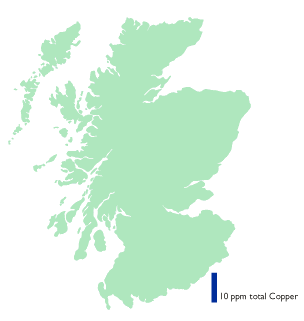Copper
 The average concentration of copper in the Earth's crust is around 60mg/kg but values given for soils are generally much lower at around 30mg/kg. Copper is an essential element for the health of plants and animals where it plays an important role in enzyme mediated systems. Plant deficiency symptoms have been observed in Scotland and, indeed, throughout the world. In plants, copper plays an important role in processes governed by enzyme systems. Comparison of the four transects shows that the mean copper content of the samples in the four transects increases from 4.7mg/kg in transect 1, 8.9mg/kg in transect 2 to 21.6mg/kg in transect 3 then decreases to 12.4mg/kg in transect 4. This pattern is also observed for other metals in the sample set. There is a slight tendency for values to increase from east to west within transect 1 whereas within transect 2 although the contents increase initially from east to west they reach a maximum before decreasing again. Within transects 3 and 4 there is considerable variation across the country. The values generally lie within the range expected for Scottish soils, where Cu deficiency has been recorded. As with the other metals the values for soils receiving sewage sludge tend to have been adopted as environmental standards for soils but the values recorded here are below both the recommended (50mg/kg) and the maximum permissible (140mg/kg) values.
The average concentration of copper in the Earth's crust is around 60mg/kg but values given for soils are generally much lower at around 30mg/kg. Copper is an essential element for the health of plants and animals where it plays an important role in enzyme mediated systems. Plant deficiency symptoms have been observed in Scotland and, indeed, throughout the world. In plants, copper plays an important role in processes governed by enzyme systems. Comparison of the four transects shows that the mean copper content of the samples in the four transects increases from 4.7mg/kg in transect 1, 8.9mg/kg in transect 2 to 21.6mg/kg in transect 3 then decreases to 12.4mg/kg in transect 4. This pattern is also observed for other metals in the sample set. There is a slight tendency for values to increase from east to west within transect 1 whereas within transect 2 although the contents increase initially from east to west they reach a maximum before decreasing again. Within transects 3 and 4 there is considerable variation across the country. The values generally lie within the range expected for Scottish soils, where Cu deficiency has been recorded. As with the other metals the values for soils receiving sewage sludge tend to have been adopted as environmental standards for soils but the values recorded here are below both the recommended (50mg/kg) and the maximum permissible (140mg/kg) values.

